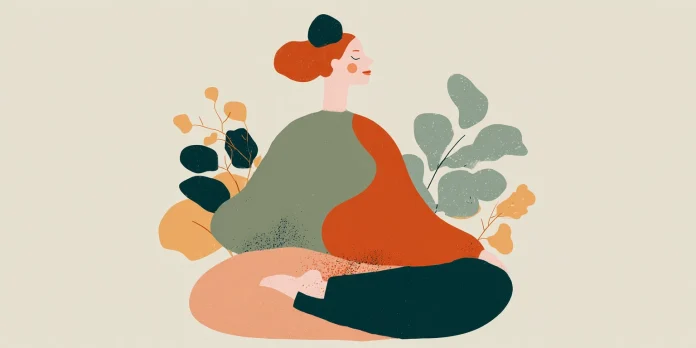Written by Susana Pontiggia (Psychologist, Specialist in Neuroscience and Human Behavioral Sciences, Consultant in Personal and Organizational Development)
Art by Valentina Taraborelli
“If, while washing the dishes, you are thinking about the cup of tea you will have afterward, you are cultivating a habit of mind in which, when drinking tea, you will already be thinking about the walk you’ll take later. In this way, you are never truly where you are.
We live between the past and the future, which is a projection of our desires.
We forget to be present in the moment.”
—Thich Nhat Hanh
Life is filled with moments of chaos—those storms of emotions where anxiety, frustration, or sadness seem overwhelming. In these times, it can feel impossible to find clarity. One powerful mindfulness tool that can help you navigate emotional turbulence is the RAIN meditation exercise. This practice, first introduced by mindfulness teacher Michele McDonald, provides a structured way to bring awareness and compassion to your inner experience.
Whether you’re dealing with a moment of stress at work, a conflict in a relationship, or just grappling with self-doubt, the RAIN meditation is a practical method to guide you through.

Let’s explore the four steps of RAIN in detail and how they can help you find peace in the middle of the storm.
1. Recognize: Naming What’s Happening
The first step in the RAIN practice is to recognize what’s going on inside you. This means pausing to notice the emotions, thoughts, or sensations that are present in the moment.Often, we rush through life on autopilot, unaware of how stress, worry, or sadness quietly builds up. By taking a moment to ask, “What’s happening inside me right now?” you shine a light on what might otherwise remain hidden.
How to Practice Recognition:
- Take a deep breath and turn your attention inward.
- Identify your current emotional state. Are you feeling anxious, angry, or sad? Perhaps multiple emotions are present—try to name each one without judgment.
- Notice any physical sensations that accompany these emotions, such as tightness in your chest or a racing heart.
Recognizing is like turning on the lights in a dark room. It doesn’t change what’s there, but it helps you see clearly.
2. Accept: Allowing What Is
The second step is acceptance, which involves welcoming your experience without judgment or resistance. This doesn’t mean you have to like what you’re feeling—it simply means acknowledging that these emotions or sensations are present.
Resistance often amplifies emotional pain. When we try to push away anxiety or anger, it tends to grow stronger. Acceptance allows you to sit with your feelings, creating space for them to naturally flow through you.
How to Practice Acceptance:
- Remind yourself that it’s okay to feel this way. Every emotion is a valid part of the human experience.
- Avoid labeling emotions as “good” or “bad.” Instead, view them as temporary visitors passing through.
- Use a phrase like, “This is what’s here right now, and that’s okay.”
Acceptance doesn’t mean resignation; it’s about letting go of the struggle against reality.
3. Investigate: Exploring with Curiosity
Once you’ve recognized and accepted your feelings, it’s time to investigate them. This step involves diving deeper into your emotional experience with curiosity and openness. It’s about understanding, not analyzing or overthinking.
Questions to Guide Your Investigation:
- What am I telling myself about this situation?
- Are there any underlying fears, assumptions, or unmet needs fueling this emotion?
- How is my body reacting? Are there areas of tension or discomfort?
- Am I viewing this situation through a specific filter or bias?
- What small action could help me feel just a little better?
The goal here isn’t to fix or solve anything—it’s to bring awareness and clarity to your inner world. Think of it as having a compassionate conversation with yourself.
4. Nurture: Offering Kindness to Yourself
The final step is to nurture yourself with care and compassion. After exploring your feelings, you may find it helpful to offer yourself kindness, much like you would comfort a dear friend.
Nurturing can take many forms, depending on what you need in the moment. It might be a kind word, a calming activity, or simply placing a hand on your heart as a gesture of self-love.
Ways to Practice Nurturing:
- Use affirming phrases like, “I’m here for you” or “It’s okay to feel this way.”
- Engage in a soothing activity, such as sipping tea, journaling, or going for a walk in nature.
- Visualize yourself surrounded by warmth, light, or love.
Nurturing helps to ground you, allowing you to move forward with a sense of calm and clarity.
The Power of RAIN
The beauty of the RAIN meditation is its simplicity and adaptability. Whether you have a few minutes or an hour, this practice can be tailored to fit your needs. Over time, it helps build emotional resilience, making it easier to face life’s challenges with grace.
The next time you find yourself caught in a storm of emotions, pause and take a moment to practice RAIN. By recognizing, accepting, investigating, and nurturing, you can transform even the most difficult moments into opportunities for growth and self-compassion.
Take a deep breath, and let RAIN wash over you.





